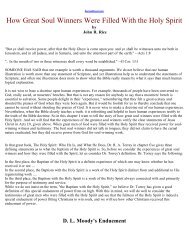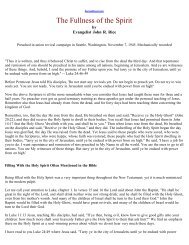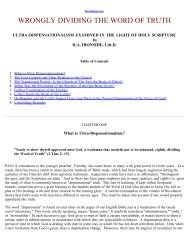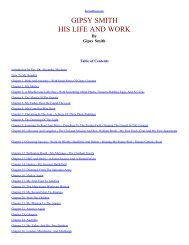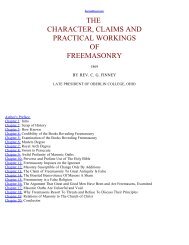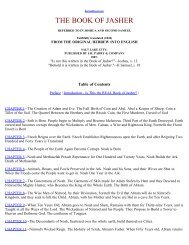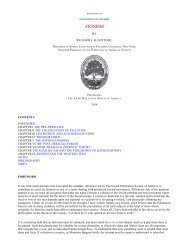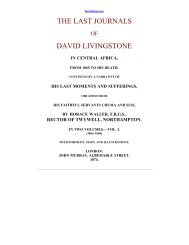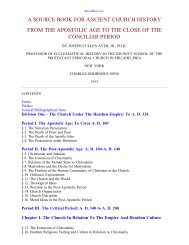Legends of Babylon and Egypt in Relation to Hebrew Tradition.pdf
Legends of Babylon and Egypt in Relation to Hebrew Tradition.pdf
Legends of Babylon and Egypt in Relation to Hebrew Tradition.pdf
You also want an ePaper? Increase the reach of your titles
YUMPU automatically turns print PDFs into web optimized ePapers that Google loves.
<strong>in</strong>terest<strong>in</strong>g, for it is clearly the same place as Iarimuta or Iarimmuta, <strong>of</strong> which we f<strong>in</strong>d mention <strong>in</strong> the Tell el-Amarna<br />
letters. From the references <strong>to</strong> this district <strong>in</strong> the letters <strong>of</strong> Rib-Adda, governor <strong>of</strong> Byblos, we may <strong>in</strong>fer that it was a<br />
level district on the coast, capable <strong>of</strong> produc<strong>in</strong>g a considerable quantity <strong>of</strong> gra<strong>in</strong> for export, <strong>and</strong> that it was under<br />
<strong>Egypt</strong>ian control at the time <strong>of</strong> Amenophis IV. Hither<strong>to</strong> its position has been conjecturally placed <strong>in</strong> the Nile Delta, but<br />
from Sargon's reference we must probably seek it on the North Syrian or possibly the Cilician coast. Perhaps, as Dr.<br />
Poebel suggests, it was the pla<strong>in</strong> <strong>of</strong> Antioch, along the lower course <strong>and</strong> at the mouth <strong>of</strong> the Orontes. But his further<br />
suggestion that the term is used by Sargon for the whole stretch <strong>of</strong> country between the sea <strong>and</strong> the Euphrates is hardly<br />
probable. For the geographical references need not be treated as exhaustive, but as conf<strong>in</strong>ed <strong>to</strong> the more important<br />
districts through which the expedition passed. The district <strong>of</strong> Ibla which is also mentioned by Narâm-S<strong>in</strong> <strong>and</strong> Gudea,<br />
lay probably <strong>to</strong> the north <strong>of</strong> Iarmuti, perhaps on the southern slopes <strong>of</strong> Taurus. It, <strong>to</strong>o, we may regard as a district <strong>of</strong><br />
restricted extent rather than as a general geographical term for the extreme north <strong>of</strong> Syria.<br />
[1] Thureau-Dang<strong>in</strong>, /Les <strong>in</strong>scriptions de Sumer de d'Akkad/, p. 108 f., Statue B, col. v. 1. 28; Germ. ed., p. 68 f.<br />
It is significant that Sargon does not allude <strong>to</strong> any battle when describ<strong>in</strong>g this expedition, nor does he claim <strong>to</strong> have<br />
devastated the western countries.[1] Indeed, most <strong>of</strong> these early expeditions <strong>to</strong> the west appear <strong>to</strong> have been <strong>in</strong>spired<br />
by motives <strong>of</strong> commercial enterprise rather than <strong>of</strong> conquest. But <strong>in</strong>crease <strong>of</strong> wealth was naturally followed by political<br />
expansion, <strong>and</strong> <strong>Egypt</strong>'s dream <strong>of</strong> an Asiatic empire was realized by Pharaohs <strong>of</strong> the XVIIIth Dynasty. The fact that<br />
<strong>Babylon</strong>ian should then have been adopted as the medium <strong>of</strong> <strong>of</strong>ficial <strong>in</strong>tercourse <strong>in</strong> Syria po<strong>in</strong>ts <strong>to</strong> the closeness <strong>of</strong> the<br />
commercial ties which had already united the Euphrates Valley with the west. <strong>Egypt</strong>ian control had passed from<br />
Canaan at the time <strong>of</strong> the <strong>Hebrew</strong> settlement, which was <strong>in</strong>deed a comparatively late episode <strong>in</strong> the early his<strong>to</strong>ry <strong>of</strong><br />
Syria. Whether or not we identify the Khabiri with the <strong>Hebrew</strong>s, the character <strong>of</strong> the latter's <strong>in</strong>cursion is strik<strong>in</strong>gly<br />
illustrated by some <strong>of</strong> the Tell el-Amarna letters. We see a nomad folk press<strong>in</strong>g <strong>in</strong> upon settled peoples <strong>and</strong> ga<strong>in</strong><strong>in</strong>g a<br />
foothold here <strong>and</strong> there.[2]<br />
[1] In some versions <strong>of</strong> his new records Sargon states that "5,400 men daily eat bread before him" (see Poebel, op. cit.,<br />
p. 178); though the figure may be <strong>in</strong>tended <strong>to</strong> convey an idea <strong>of</strong> the size <strong>of</strong> Sargon's court, we may perhaps see <strong>in</strong> it a<br />
not <strong>in</strong>accurate estimate <strong>of</strong> the <strong>to</strong>tal strength <strong>of</strong> his armed forces.<br />
[2] See especially Pr<strong>of</strong>essor Burney's forthcom<strong>in</strong>g commentary on Judges (passim), <strong>and</strong> his forthcom<strong>in</strong>g Schweich<br />
Lectures (now delivered, <strong>in</strong> 1917).<br />
The great change from desert life consists <strong>in</strong> the adoption <strong>of</strong> agriculture, <strong>and</strong> when once that was made by the <strong>Hebrew</strong>s<br />
any further advance <strong>in</strong> economic development was dictated by their new surround<strong>in</strong>gs. The same process had been<br />
go<strong>in</strong>g on, as we have seen, <strong>in</strong> Syria s<strong>in</strong>ce the dawn <strong>of</strong> his<strong>to</strong>ry, the Semitic nomad pass<strong>in</strong>g gradually through the stages<br />
<strong>of</strong> agricultural <strong>and</strong> village life <strong>in</strong><strong>to</strong> that <strong>of</strong> the city. The country favoured the retention <strong>of</strong> tribal exclusiveness, but<br />
ultimate survival could only be purchased at the cost <strong>of</strong> some amalgamation with their new neighbours. Below the<br />
surface <strong>of</strong> <strong>Hebrew</strong> his<strong>to</strong>ry these two tendencies may be traced <strong>in</strong> vary<strong>in</strong>g action <strong>and</strong> reaction. Some sections <strong>of</strong> the<br />
race engaged readily <strong>in</strong> the social <strong>and</strong> commercial life <strong>of</strong> Canaanite civilization with its rich <strong>in</strong>heritance from the past.<br />
Others, especially <strong>in</strong> the highl<strong>and</strong>s <strong>of</strong> Judah <strong>and</strong> the south, at first succeeded <strong>in</strong> keep<strong>in</strong>g themselves remote from<br />
foreign <strong>in</strong>fluence. Dur<strong>in</strong>g the later periods <strong>of</strong> the national life the country was aga<strong>in</strong> subjected, <strong>and</strong> <strong>in</strong> an <strong>in</strong>tensified<br />
degree, <strong>to</strong> those forces <strong>of</strong> political aggression from Mesopotamia <strong>and</strong> <strong>Egypt</strong> which we have already noted as operat<strong>in</strong>g<br />
<strong>in</strong> Canaan. But throughout the settled <strong>Hebrew</strong> community as a whole the spark <strong>of</strong> desert fire was not ext<strong>in</strong>guished, <strong>and</strong><br />
by k<strong>in</strong>dl<strong>in</strong>g the zeal <strong>of</strong> the Prophets it eventually affected nearly all the white races <strong>of</strong> mank<strong>in</strong>d.<br />
In his Presidential Address before the British Association at Newcastle,[1] Sir Arthur Evans emphasized the part which<br />
recent archaeology has played <strong>in</strong> prov<strong>in</strong>g the cont<strong>in</strong>uity <strong>of</strong> human culture from the most remote periods. He showed<br />
how gaps <strong>in</strong> our knowledge had been bridged, <strong>and</strong> he traced the part which each great race had taken <strong>in</strong> <strong>in</strong>creas<strong>in</strong>g its<br />
<strong>in</strong>heritance. We have, <strong>in</strong> fact, ample grounds for assum<strong>in</strong>g an <strong>in</strong>terchange, not only <strong>of</strong> commercial products, but, <strong>in</strong> a<br />
m<strong>in</strong>or degree, <strong>of</strong> ideas with<strong>in</strong> areas geographically connected; <strong>and</strong> it is surely not deroga<strong>to</strong>ry <strong>to</strong> any <strong>Hebrew</strong> writer <strong>to</strong><br />
suggest that he may have adopted, <strong>and</strong> used for his own purposes, conceptions current among his contemporaries. In<br />
other words, the vehicle <strong>of</strong> religious ideas may well be <strong>of</strong> composite orig<strong>in</strong>; <strong>and</strong>, <strong>in</strong> the course <strong>of</strong> our study <strong>of</strong> early<br />
<strong>Hebrew</strong> tradition, I suggest that we hold ourselves justified <strong>in</strong> apply<strong>in</strong>g the comparative method <strong>to</strong> some at any rate <strong>of</strong><br />
the <strong>in</strong>gredients which went <strong>to</strong> form the f<strong>in</strong>ished product. The process is purely literary, but it f<strong>in</strong>ds an analogy <strong>in</strong> the



